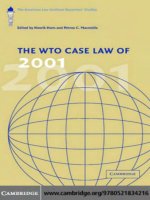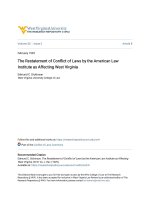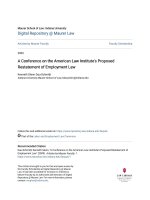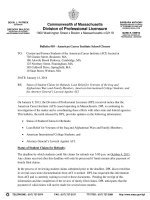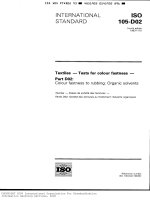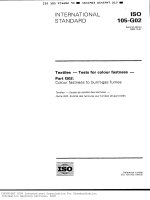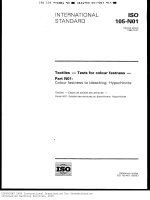Api publ 4589 1993 scan (american petroleum institute)
Bạn đang xem bản rút gọn của tài liệu. Xem và tải ngay bản đầy đủ của tài liệu tại đây (10.22 MB, 253 trang )
A P I PUBL*4589 93
m 0732290 0517489
9Lb
m
Fugitive Hydrocarbon Emissions
from Oil and Gas Production
Operations
HEiALTH AND ENVIRONMENTAL SCIENCES
API PUBLICATION NUMBER 4589
DEXEMBER 1993
--`,,-`-`,,`,,`,`,,`---
American Petroleum Institute
1220 L Street. Northwest
Washington, D.C. 20005
Environmental Purtnership
Copyright American Petroleum Institute
Provided by IHS under license with API
No reproduction or networking permitted without license from IHS
Not for Resale
11’
A P I P U B L * 4 5 8 9 33
0732290 0537490 638 W
Fugitive Hydrocarbon Emissions from
Oil and Gas Production Operations
Health and Environmental Sciences Department
PUBLICATION NUMBER 4589
PREPARED UNDER CONTRACTBY:
STAR ENVIRONMENTAL
P.O. BOX 13425
TORRANCE, CA 90503
DECEMBER 1993
American
Petroleum
Institute
--`,,-`-`,,`,,`,`,,`---
Copyright American Petroleum Institute
Provided by IHS under license with API
No reproduction or networking permitted without license from IHS
Not for Resale
A P I PUBL*45B9
93
0732290 0.537493 5 7 4
m
FOREWORD
API PUBLICATIONS NECESSARILY ADDRESS PROBLEMS OF A GENERAL
NATURE. WITH RESPECT TO PARTICULAR CIRCUMSTANCES,LOCAL, STATE,
AND FEDERAL LAWS AND REGULATIONS SHOULD BE REVIEWED.
API ISNOT UNDERTAKING TO MEET THE DUTIES OF EMPLOYERS, MANUFACTURERS, OR SUPPLIERS To WARN AND PROPERLY TRAIN AND EQUIP THEIR
EMPLOYEES, AND OTHERS EXPOSED, CONCERNINGHEALTH AND SAFETY
RISKS AND PRECAUTIONS, NOR UNDERTAKINGTHEIR OBLIGATIONS UNDER
LOCAL, STATE, ORFEDERAL LAWS.
NOTHING CONTAINED INANY API PUBLICATION IS TO BE CONSTRUED AS
GRANTING ANY RIGHT, BY IMPLICATION OR OTHERWISE, FOR THE MANUFACTURE, SALE, OR USE OF ANY METHOD, APPARATUS, OR PRODUCT COVERED BY LETTERS PATENT. NEITHER SHOULD ANYTHING CONTAINEDIN
THE PUBLICATION BECONSTRUEDAS INSURING ANYONE AGAINST LIABILITY FOR INFRINGEMENT OF LETERS PATENT.
Copyright O 1993 American Petroleum Institute
--`,,-`-`,,`,,`,`,,`---
Copyright American Petroleum Institute
Provided by IHS under license with API
No reproduction or networking permitted without license from IHS
II
Not for Resale
A P I PUBLX4589 93
0732290 0537472 400
m
ACKNOWLEDGMENTS
THE FOLLOWING PEOPLEARE RECOGNIZED FOR THEIR CONTRIBUTIONS OF
TIME AND EXPERTISE DURING THIS STUDY AND IN THE PREPARATION OF
THIS REPORT
MI STAFF CONTACT(s’L
Dr. Paul Martino, Health andEnvironmental Sciences Department
MEMBERS OF THE FUGITIVE EMISSIONS PROJECT GROUP
John Bourke, ARCO Oil andGas Company
Kerry Mire, Texaco E&P, Inc.
Vick Newsom, Amoco Corporation
Mark Pike, Exxon Corporation
Dr. Raghavan Ramanan, Mobil Exploration & Production
Andy Shah, Conoco Inc.
Jim Suong, Unocal Corporation
Charles Tixier, Shell Oil Company
Dr. Jenny Yang, Mamthon OilCompany
--`,,-`-`,,`,,`,`,,`---
STAR Environmental would also like to thank Dr. Paul Wakim (American Petroleum
Institute) for conducting the statistical analysis of thedata and assistance in developing
the correlation equations and emission factorspresented in the appendix of this report.
The valuable guidance of Robert Lott (Gas Research Institute) both during the course of
the study andthe review of the final repon is gratefully acknowledged,
...
111
Copyright American Petroleum Institute
Provided by IHS under license with API
No reproduction or networking permitted without license from IHS
Not for Resale
API P U B L X 4 5 8 9 9 3 m 0 7 3 2 2 9 0 0 5 1 7 4 9 3 347
PREFACE
--`,,-`-`,,`,,`,`,,`---
This report presents final resultsof an APVGRI study entitled "Fugitive
Hydrocarbon Emissions from Oil and Gas Production Operations". The
data collection efforts and development of correlation equations and emission factors for fugitive hydrocarbon emissions fromoil and gas production
operations described in this report include onshore light crude facilities,
onshore heavy crude facilities,onshore gas production facilities, and offshore oil and gasfacilities. A gas processing plant correlation equation is
included, but emission factors for gas processing plants are not. Emission
factors for gas processing plants will be determined in 1994 and reported in
a separate report after more
field data are collected ina joint research effort
with the EPA. The statistical analysis of the data gatheredin this study was
conducted in accordance with the US EPA Protocol for Equipment Leak
Emission Estimates (EPA-453/R-93-026, June1993) to facilitate acceptance by the EPA. The American Petroleum Institute does not necessarily
endorse the EPA protocol as the best method for analyzing the data inthis
study. There may be other methods of statistical analysis that are more
appropriate. In this study, as in the EPA protocol, the common convention
of reporting emission factors to three significant figures has been followed,
even though it may not be warranted given the inherent variation
in the precision and accuracy of emissions measurements.
Copyright American Petroleum Institute
Provided by IHS under license with API
No reproduction or networking permitted without license from IHS
Not for Resale
A P I P U B L * 4 5 8 9 93
m 0732290 0537494 283 m
--`,,-`-`,,`,,`,`,,`---
ABSTRACT
In 1980, the American Petroleum Institutepublished emission factors for
fugitive hydrocarbon emissions from onshoreand offshore petroleum production sites. The new emission factors developed fromthis joint study
by API and the Gas Research Institute replace the existing1980 API factors. More than 180,000 components were screened using EPAMethod
21 guidelines and over 700 leaks were speciated to determinenew emission rates of total hydrocarbons, volatile organic compounds,and individual air toxics (¡.e., benzene, toluene, ethyl benzene, and xylenes).
The new study has also produced emission correlation equations that
can be usedto predict mass emission rates from individualinstrument
screening values. These equations allow operators to more accurately
quantify actual emissions from their site rather than relying on
generalized emission factors. This greatly improves assessment of control tech
nologies and selection of equipment to lower fugitive hydrocarbon
emissions. As the new leak definition imposed by the Clean Air Act
Amendments of 1990 becomes effective, results of this study will be
indispensable to operators.
Results of the study are summarizedin easy-to-read graphics and easyto-use factors. A workbook presented at theend of the report allows site
operators to tailor the new factors and equations to their
individual use.
V
Copyright American Petroleum Institute
Provided by IHS under license with API
No reproduction or networking permitted without license from IHS
Not for Resale
A P I PUBL*4589 9 3
m 0732290
TABLE
OF
0537495
LLT
CONTENTS
SECTION
PAGE
Scope ...................................................................................................................
DESCRIPTION OF METHODOLOGY ..........................................................................
1-1
1-2
Study Site Selection.............................................................................................
Screening Procedures...........................................................................................
Bagging Procedures.............................................................................................
Laboratory Procedures.........................................................................................
Quality Assurance/Quality Control Procedures...................................................
DATA MANAGEMENT.....................................................................................................
Development of Correlation Equations.................................................................
1-3
1-4
1-6
1-8
1-8
1-9
1-9
Development of Emission Factors......................................................................
1-10
2. ONSHORE RESULTS AND ANALYSIS ...............................................................................
2-1
DATA COLLECTION ...................................................................................................... 2-1
2-5
QUALITY ASSURANCE/QUALITY CONTROL ............................................................
CORRELATION EQUATIONS ....................................................................................
2-16
EMISSION FACTORS..................................................................................................
2-21
2-21
Average Emission Factors..................................................................................
LeaWNo Leak Emission Factors
.......................................................................... 2-22
Stratified Emission Factors..................................................................................
2-22
SPECIATION OF EMISSIONS .................................................................................... 2-22
REGIONAL DIFFERENCES IN FUGITIVE EMISSIONS .............................................
2-36
CONTROL EFFICIENCY OF INSPECTION AND MAINTENANCE PROGRAMS.... 2-36
3. OFFSHORE RESULTS AND ANALYSIS
..............................................................................
3-1
DATA COLLECTION ......................................................................................................
3-1
QUALITY ASSURANCE/QUALITY CONTROL ............................................................ 3-4
CORRELATION EQUATIONS ...................................................................................... 3-5
EMISSION FACTORS....................................................................................................
3-7
3-7
Average Emission Factors....................................................................................
LeaWNo Leak Emission Factors
............................................................................
3-7
Stratified Emission Factors....................................................................................
3-7
SPECIATION OF EMISSIONS ......................................................................................
3-8
Copyright American Petroleum Institute
Provided by IHS under license with API
No reproduction or networking permitted without license from IHS
Not for Resale
--`,,-`-`,,`,,`,`,,`---
EXECUTIVE SUMMARY.......................................................................................................... e5-1
1. STUDY METHODOLOGY.....................................................................................................
1-1
INTRODUCTION ............................................................................................................
1-1
1-1
Objectives............................................................................................................
A P I PUBLJ4587 73
0732270
05L7476
056
T A B L E OF CONTENTS (Continued)
PAGE
SECTION
3. OFFSHORE RESULTS AND ANALYSIS (Continued)
REGIONAL DIFFERENCES IN FUGITIVE EMISSIONS .............................................
3-14
CONTROL EFFICIENCY OF INSPECTION AND MAINTENANCE PROGRAMS.... 3-15
FUGITIVE EMISSIONS WORKBOOK .....................................................................................
W-1
LIST OF A P P E N D I C E S
APPENDIX A STATISTICAL ANALYSIS OF DATA ..................................................................
A.1
APPENDIX B: FIELD INVENTORY SHEET DATA ....................................................................
B-1
APPENDIX C EMITTER DATA..................................................................................................
C-1
APPENDIX D NONAROMATIC SPECIATION DATA...............................................................
APPENDIX E AROMATIC SPECIATION DATA........................................................................
D-1
E-1
--`,,-`-`,,`,,`,`,,`---
Copyright American Petroleum Institute
Provided by IHS under license with API
No reproduction or networking permitted without license from IHS
Not for Resale
A P I PUBLa4589 93 W 0732290 0517Y97 T 9 2 W
LIST OF TABLES
TABLE
PAGE
ES-1
Number of Components Screened. Emitters Found.and Samples Collectedand
Analyzed during APVGRI Study ...................................................................................
Equations
.............................................................................................
ES-2 Correlation
..............................................................................
ES-3 Default Zero THC Emission Factors
ES-4 Average THC Emission Factors (Overall) ....................................................................
ES-5 Average THC Emission Factors (ComponentSpecific)................................................
e5-2
e5-5
e5-5
e5-6
e5-6
e5-6
e5-7
e5-7
............................................................................
ES-6 LeaWNo Leak THC Emission Factors
ES-7 Stratified THC EmissionFactors....................................................................................
ES-8 Speciated Hydrocarbon Factors....................................................................................
1-1
Sites Included in the 1993 APVGRI Study.......................................................................
1-4
2- 1 Components Screened and Emitters Found at Onshore Sites
........................................ 2-2
Onshore Emitters by Screening Range........................................................................... 2-2
2-2
Contribution of Each Screening Rangeto Total Emissions.............................................. 2-4
2-3
2-4
First and Second Analyses for Nonaromatic Hydrocarbons
............................................. 2-6
First and Second Analyses for Aromatic Hydrocarbons.................................................
2-12
2-5
2-6
2-7
2-8
2- 9
2-1 o
2-1 1
2-1 2
2-1 3
2-1 4
3-1
3-2
3-3
3-4
3-5
3-6
3-7
3-8
3-9
Correlation of Repeated Laboratory Analyses..............................................................
Correlation Equations.....................................................................................................
Default Zero THC Emission Factors
...............................................................................
Average THC Emission Factors (Overall) .....................................................................
Average THC Emission Factors (Component specific).................................................
LeaWNo-Leak THC Emission Factors
............................................................................
Stratified THC Emission Factors
.....................................................................................
Weight Fractionof Emissions by Number ofCarbons...................................................
2-15
2-17
2-21
2-21
2-21
2-22
2-22
2-36
Average Emission Rate of Components with lSVs of 1 00,O00 ppmv (By region) ..... 2-36
Components Screenedand Emitters Found at Offshore Platforms
.................................. 3-1
Offshore Emitters by Screening Range...........................................................................
3-2
Contribution of Each Screening Rangeto Total Emissions.............................................. 3-4
Correlation Equations.......................................................................................................
3-5
Default Zero THC Emission Factors
................................................................................. 3-5
Average THC Emission Factors (Overall) ....................................................................... 3-7
Average THC Emission Factors (Component specific)
................................................... 3-7
LeaWNo-Leak THC Emission Factors
.............................................................................. 3-7
Stratified THC Emission Factors
....................................................................................... 3-8
--`,,-`-`,,`,,`,`,,`---
Copyright American Petroleum Institute
Provided by IHS under license with API
No reproduction or networking permitted without license from IHS
Not for Resale
LIST OF TABLES (Continued)
PAGE
SECTlON
3-1O
3-1 1
--`,,-`-`,,`,,`,`,,`---
3-12
Weight Fraction of Emissions by Number of Carbons ..................................................... 3-8
Number of Components Installed on Pacific OCS Platforms Monitored by the
MMS, and the Average Leak Rates............................................................................... 3-14
Fugitive Hydrocarbon Emissions Predicted by MMS and API/GRI Correlation
Equations....................................................................................................................... .3-14
Copyright American Petroleum Institute
Provided by IHS under license with API
No reproduction or networking permitted without license from IHS
Not for Resale
A P I PUBL*4589 93
m
0 7 3 2 2 9 0 0537499 8 6 5
m
LIST OF FIGURES
PAGE
FlGURE
--`,,-`-`,,`,,`,`,,`---
1-1
2-1
2-2
2-3
2-4
2-5
2-6
2-7
2-8
2-9
2-1O
2-11
2-12
2-13
2-14
2-15
2-16
2-17
2-18
2-19
2-20
2-21
2-22
2-23
2-24
2-25
2-26
2-27
2-28
2-29
2-30
2-31
2-32
3-1
3-2
1993 API/GRIStudy Sites ...............................................................................................
Distribution of OnshoreEmitters .......................................................................................
Percent of Total Emission by Range ................................................................................
Comparison of Repeat AnalysesatLaboratory (Cl) .....................................................
Comparison of Repeat Analyses at Laboratory (C2) .....................................................
Comparison of Repeat Analyses at Laboratory (C3)...................................................
Comparison of Repeat Analyses at Laboratory (C4) ...................................................
Comparison of Repeat Analyses at Laboratory (C5) ...................................................
Comparison of Repeat Analyses at Laboratory (C6+) .................................................
Comparison of Repeat Analyses at Laboratory (Benzene) ..........................................
Comparison of Repeat Analyses at Laboratory (Toluene) ...........................................
Comparison of Repeat Analyses at Laboratory (Ethyl-Benzene) ................................
Comparison of Repeat Analyses at Laboratory (m+p Xylene) .....................................
Comparison of Repeat Analyses at Laboratory (o Xylene) ..........................................
Comparison of Onshore Sample Bags as Collected and as Analyzed ........................
Light Crude Production Correlation (CN. VL, OEL)........................................................
Light Crude Production Correlation (Others)..................................................................
Heavy Crude Production Correlation (CN, VL, OEL, Others).......................................
Natural Gas Production Correlation (CN, OEL) .............................................................
Natural Gas Production Correlation (VL, Others)...........................................................
Natural Gas Processing Correlation (CN, VL, OEL, Others) .........................................
Weight Percent Hydrocarbons in Samples (Light Crude #1) .........................................
Weight Percent Hydrocarbons in Samples (Light Crude #2).........................................
Weight Percent Hydrocarbons in Samples (Light Crude #3).........................................
Weight Percent Hydrocarbons in Samples (Light Crude #4).........................................
Weight Percent Hydrocarbons in Samples (Heavy Crude #5, 6,7 , & 8)......................
Weight Percent Hydrocarbons in Samples (Gas Production #9) ...................................
Weight Percent Hydrocarbons in Samples (Gas Production #lo).................................
Weight Percent Hydrocarbons in Samples (Gas Production #1 1).................................
Weight Percent Hydrocarbons in Samples (Gas Production #12).................................
Weight Percent Air Toxics in Light Crude Emissions ......................................................
Weight Percent Air Toxics in Heavy Crude Emissions ..................................................
Weight Percent Air Toxics in Gas Production Emissions ................................................
Distribution of OffshoreEmitters .......................................................................................
Percent of Total Emission by Range................................................................................
Copyright American Petroleum Institute
Provided by IHS under license with API
No reproduction or networking permitted without license from IHS
Not for Resale
1-3
2-3
2-3
2-9
2-9
2-10
2-10
2-11
2-11
2-13
2-13
2-14
2-14
2-15
2-16
2-18
2-18
2-19
2-19
2-20
2-20
2-24
2-25
2-26
2-27
2-28
2-29
2-30
2-31
2-32
2-33
2-34
2-35
3-3
3-3
.&PI P U B L X 4 5 8 9 9 3 m 0732290 0 5 1 7 5 0 0 307 m
LIST OF FIGURES (Continued)
Fgure
Paae
3-3
3-4
3-5
Comparison of Offshore Sample Bags as Collected and as Analyzed ..........................
Offsholre Production Correlation (CN.OEL) ....................................................................
Offshore Production Correlation(VL. Others) ..................................................................
3-4
3-6
3-6
3-6
3-7
3-8
3-9
Weight Percent Hydrocarbons in Samples (Offshore #17) .............................................
3-9
3-1O
3-1 1
3-12
3-13
3-14
Weight Percent Hydrocarbons in Samples (Offshore #18) ...........................................
Weight Percent Hydrocarbons inSamples (Offshore #19) ...........................................
3-10
3-11
Weight Percent Hydrocarbons in Samples (Offshore #20) ...........................................
Weight Percent AirToxics in Gulf Offshore Emissions...................................................
3-12
3-13
MMS Connection and Open-Ended Line Data with APVGRI Offshore Equations........ 3-16
MMS Valve and Other Data with APVGRI Offshore Equations ....................................
3-16
Distribution of Pacific OCS Emitters
...............................................................................
3-17
Percent of Total Emissions by Range (Pacific OCS Platforms).....................................
--`,,-`-`,,`,,`,`,,`---
Copyright American Petroleum Institute
Provided by IHS under license with API
No reproduction or networking permitted without license from IHS
Not for Resale
3-17
EXECUTIVE SUMMARY
INTRODUCTION
The American Petroleum Institute (API) and the
Gas Research Institute (GRI) conducted an extensive
field study of fugitive hydrocarbon emissions from petroleum production operations. Data were
collected from184,035 components at20 different sitesand used to develop new emission factors and
correlation equations. This report contains new emission factors for light crude production sites, heavy
crude production sites, gas production sites, and Gulf
of Mexico (Gulf) offshore petroleum production
operations that supersede those published
by API in "Fugitive Hydrocarbon Emissions from Petroleum
Production Operations, VolumesI and II," (1980). Emission factors for gas processing plants will be
published in a separate report after the collection
of additional field data.This report also contains
emission correlation equations that can be used to calculate fugitive emissions from individual instrument
screening values (ISV) obtained with portable hydrocarbon monitoring instruments
at all types of
petroleum production facilities.
OBJECTIVES
Objectives of the study were:
l.
Development of correlationequationsrelatinginstrumentscreeningvaluestomass
emission rates;
2.
Development of emission
factors;
3.
Development of profiles of speciatedhydrocarbonemissionsincludingairtoxics;
4.
Assessment of regionaldifferences in fugitiveemissions;and,
5.
Assessment of controlefficiency of InspectionandMaintenanceprograms.
STUDY GUIDELINES AND PROCEDURES
The following types of petroleum production facilities were visited:
Onshore light crude production
Onshore heavy crude production
Onshore natural gas production
Onshore natural gas processing plants
Gulf of Mexico offshore platforms
At the beginning of each site visit, monitoring personnel met with representatives of the operating
company to become oriented with the facility lay-out and safety requirements. Monitoringand sample
collection activities started immediately after the orientation meetings. The following precautions were
ES-1
--`,,-`-`,,`,,`,`,,`---
Copyright American Petroleum Institute
Provided by IHS under license with API
No reproduction or networking permitted without license from IHS
Not for Resale
taken to assurethat monitoring data and hydrocarbon samples were representative of the normal
operating conditionof each facility:
Monitoring work was conducted without petroleum company supervision;
Coimponents that gave elevated screening values were recorded on
confidential field data sheets (these were not shown to oil company
personnel until the end of the visit);
No identification markers were attachedto emitting components during the
time between screening and hydrocarbon collection;
Collection of fugitive hydrocarbon emission samples occurred as soon after
detection as possible to minimize the possibility of changes due to
maintenance activities.
--`,,-`-`,,`,,`,`,,`---
During the firstdays of each visit, all components were counted, logged,and screened with portable
All elevated readings (1O
hydrocarbon monitoring instruments equipped with flame ionization detectors.
parts-per-millicm by volume, methane equivalence [ppmv]or more) were recorded; descriptive
information about each component thatgave an elevated reading was also recorded. [NOTE:
Components with lSVs of 10 ppmv or more arereferred to in this report as “emitters.”]
Approximately 15 percent of the emitters were enclosedin polyethylene tents to collect samples of the
fugitive hydrocarbons. [NOTE: This procedure is referred to herein as “bagging”.] All of the collected
samples were speciated into C1 through C6+ fractions. Approximately 25 percent of the samples
were also analyzed for air toxics. Mass emission rates werecalculated for all the bagged emitters.
Table ES-1 shows the number of components screened, the number of emitters found,
and the number
of samples collected at each of the five types of petroleum production facilities. The table also shows
the number of samplesspeciated into C1 through C6+ fractions,and the number analyzed for aromatic
air toxics.
Table ES-1.
I
NUMBER OF COMPONENTS SCREENED, EMITTERS FOUND,ANDSAMPLES
COLLECTED AND ANALYZED FOR THE APVGRI STUDY
FACILITY’
TOTAL
I COMPONENTS I
EMITTERS I EMITTERS I A N A L Y Z E D I A N A L Y Z E D
SCREEN
FO
ED
USNADM
* PLED
Cl -C6+ Air Toxics
99 1
165
165
43
48 , 652
62
4
30
30
13,756
92
92
43
1,513
40,178
175
175
40
35,764
1,615
24361 5
243
38
45,685
184,035
4,796
705
168705
*NOTE: Emitter = ISV 21 O ppmv
ES-2
Copyright American Petroleum Institute
Provided by IHS under license with API
No reproduction or networking permitted without license from IHS
Not for Resale
I
A P I PUBL*4589 9 3
m 0732290 0517503
OLb
m
During the inventory task, components were
grouped as follows:
--`,,-`-`,,`,,`,`,,`---
1.
Connections (CN)
2.
Valves
(VL)
3.
Open Ended Lines (OEL)
4.
Compressor Seals (CS)
5.
Pump Seals (PS)
6.
Pressure
Relief
Valves
(PRV)
7.
Dump Lever
Arms
8.
Polished Rod Pumps
(ROD)
9.
Miscellaneous (MISC)
(DM)
During data analysis, component types4 through 9 were combined into a single "Others" category.
Correlation equations were developed from speciation
data to show the relationshipbetween lSVs and
mass emission rates. A separate correlation equation was sought for each
of four component types
(CN, VL, OEL, Other) at each of the five types of facility, however, several of the sub-sets of data
were found tobe statistically identical and were therefore combinedby type of facility. "Default zero"
emission rates were defined for components with lSVs below 1O ppmv.
ISVs. This was done
Emission factors were developed using the correlation equations and 184,035
all
by calculating an emission rate for each ISV using the appropriate correlation equation, then adding all
calculated emission rates for each facility type/component type combination
to give the total expected
emission rates. "Average" emission factors (average emissions per installed components) were
derived by dividing total emissionsby the total number of components. "LeaWNo Leak" and "Stratified"
emission factors weredeveloped by grouping the data according to ISVs. Speciated weight fractions
(Cl through C6+, and air toxics) of fugitive emission were also developed.
RESULTS
Correlation equations were developed for all five types
of petroleum production facilities; emission
factors were developed for four
of the five types of facilities. Additionaldata are being collected for gas
plants after which those emission factors will be calculated and presented
in a separate report.
Statistical evaluationshowed that because manyof the correlation equations were statistically
equivalent; onlyeight equations were neededto predict emissions from the five types of facilities.
ES-3
Copyright American Petroleum Institute
Provided by IHS under license with API
No reproduction or networking permitted without license from IHS
Not for Resale
A P I PUBL*4589 93
0732290 05'17504 T52
m
Emission factorswere developed for the same categories as the correlation equations
(except gas
processing plants). Speciation factors were developed for each site type. The five types of facilities
were defined as follows:
(&Shore liaht crude rsroduction sites. This group included onshore
prclduction sites that produced only oil and sites thatproduced oil mixed
with gas. Oil produced at these sites had an API gravity of 20 or more.
$&shore heaw crude production sites. Sites that produced oil with an API
gravity less than 20 were designated as heavy crude sites. Thermally
enhanced oil recovery sites were included in this category.
mshore
oroduction sites, This category included sites that produced
dry natural gas, natural gas liquids, condensate,or a very minor amount of
light oil along with theproduced gas. Equipment located along-sidethe
wells or at gathering stations wereincluded in this category. Co-located
gas plants were counted in the Onshore gas processing plant category.
m5hore aas orocessina plants. Onshore plants that process natural gas
andlor natural gas liquids were included in this category. Wells
located
adjacent to the gas plant were counted in the Onshore gas production
category instead of this category.
affshore oil and
productionplatforms, All offshoreoperations were
inc~ludedin this category.
offshore platforms. Comparison of the data produced by this study of Gulf platforms with study data
published by the US Minerals Management Service ("S)
in "Fugitive Hydrocarbon Emissions From
Pacific OCS Facilities, Volumes 1 and 2," (November 1992), indicated that Pacific
platforms have a
lower leak frequency thanGulf platforms. Offshore platforms in either area have lower leak frequencies
than onshore facilities.
Ninety percent of fugitive hydrocarbon emissions observed in this study came from components that
had large leak!; (usually less than one percentof the total installed components). This suggests that
an inspection and maintenance program that can reduce the number
of large leaks maybe effective in
reducing total fugitive hydrocarbon emissions.
Correlation EqlJatiOnS
Correlations between lSVs and mass emission rates werecalculated from laboratory analyses for lSVs
above 1O ppmv. Correlation equations were developed by regressing the natural logarithm of total
hydrocarbon elmissions (ln THC) on the natural logarithm of the instrumentscreening values (ln ISV).
A simple linear regression (least squares
fit) was then calculatedand converted from log space to
arithmetic space using a scalebias correction factor. TableES-2 gives the correlation equationsfor all
types of sites.
ES-4
Copyright American Petroleum Institute
Provided by IHS under license with API
No reproduction or networking permitted without license from IHS
Not for Resale
--`,,-`-`,,`,,`,`,,`---
No evidence of statistical differences among different regions
of the country wasfound except for
A P I PUBLm4589 9 3
Table ES-2.
~~~
~
FACILITY
COMPONENT
Onshore
Light
Crude
CN,
Onshore
Light
Crude
Other
THC(
Ib/day)
Onshore
Heavy
Crude
Onshore
Gas
Production
CN,
OEL
THC(
Ib/day)
Onshore
Gas
Production
Onshore
Plant
Gas
Offshore Oil & Gas
Offshore Oil & Gas
~~
~
~
m
0732290 0537505 999
m
CORRELATION
EQUATIONS
~-~
- ~~~
~~
~
TYPE
CORRELATION
EQUATION
= 8.61 x 1O-5(lSV p p r n ~ ) ~ . ~ ~
= 1.24 x 1
ISV pprnv)0.61
All
THC(
Ib/day)
= 3.29 x 1O-5(ISV pprnv)0.89
= 8.04 x 1O-6( ISV pprnv)' .o2
VL, Other
THC(lb/day)
= 9.79 x 10-5(lSV p p r n ~ ) ~ - ~ ~
All
THC(
Ib/day)
= 1.79 x 1O-4( ISV pprn~)0.8~
CN, OEL
THC(Ib/day) = 1.O4 x 1
ISV p p r n ~ ) ~ . ~ ~
VL, Other
THC(lb/dav\ = 3.30 x 10-4f1SV o ~ r n v \ 0 - 8 ~
VL, OEL
THC(lb/day)
NOTE: All correlation equations and emission
factors presented inthis report are based onlSVs
obtained within 1 cm of the Component surfaces.
gefault Zero Emission Factors
0.00008 to 0.00505 Ib/day for components with
The correlation equations predict emission rates from
lSVs of 1O ppmv depending on the facility type and component type. In this report, all components
with screening values below 10 ppmv have been assumed to leak at rates that produce lSVs of 5
ppmv. Table ES-3 gives the THC default zeros.
Table ES-3.
DEFAULTZERO THC EMISSION FACTORS
Averaae Emission Factors
Average emission factors are usedto predict fugitive hydrocarbon emissions when
the only information
available about a siteis the number of components installed. Average factors for four types of sites
(excluding gas plants) were developed by dividing total
emissions by the total number of installed
components. Average emission factors for individual component types were developed bydividing
the component type's contribution to total emissionsby the number of those components. Table ES-4
gives the overall average THC emission factors for each facility type; Table ES-5 gives component
specific average THC emission factors for each facilitytypekomponent type combination.
ES-5
--`,,-`-`,,`,,`,`,,`---
Copyright American Petroleum Institute
Provided by IHS under license with API
No reproduction or networking permitted without license from IHS
Not for Resale
API PUBL*4589 9 3 m 0 7 3 2 2 9 0 0537506 8 2 5 m
Table ES-4. AVERAGE THC EMISSION FACTORS
(Overall)
0.0085
0.0002
0.0233
0.0055
All
All
All
All
Ib/day-component
Ib/day-component
Ib/day-component
Ib/day-component
Table ES-5
AVERAGE THC EMISSION FACTORS
(Component specific)
rlb/dav-comDonentl
CONNECTIONS
0.0041
0.0001
Onshore Gas Production
0.0006
0.01 97
0.001 o
0.0002
0.1 063 0.0038 0.01 07
0.021 7
OTHERS OPEN-ENDE
0.0991 0.0351
0.0007
0.2870
O.1036 0.0099
I eak/No Leak EmissionF a c m
Another methold of calculating fugitive hydrocarbon emissions is to screen components
and determine
the number above and below a leak definition (in ppmv). “LeaWNo Leak“ THC emission factors are
given in Table ES-6.
1
FACILITY
TYPE
I
“LEAUNO-LEAK’’ THC EMISSION FACTORS
(PounddDay-Component)
COMP.
TYPE
CN, VL, OEL
Other
All
CN, O E L
VL, Other
CN, O E L
VL, Other
I Leak
No Leak
4 0,000 pprnv
0.00060
0.01 660
0.00016
0.00021
0.00546
>10,000 pprnv
I
0.91
0.878
0.1 19
0.380
2.45
0.1 83 0.00012
2.22 0.00267
Stratified EmissionFact=
Stratified THC lemissionfactors given in Table ES-7 show the emission rates for components with
lSVs below 1O ppmv; from 1O to 9,999 ppmv; from 10,000 to 99,999; and equal to or greater than
100,000 ppmv.
ES-6
Copyright American Petroleum Institute
Provided by IHS under license with API
No reproduction or networking permitted without license from IHS
Not for Resale
--`,,-`-`,,`,,`,`,,`---
Table ES-6.
A P I PUBL*45B9 93
Table ES-7.
m 0732290 0537507 761 m
"STRATIFIED" THC EMISSION FACTORS
Pounds/Da -Com onent
~~
Speciated Hydrocarbon Factors
Tables ES-2 through ES-7 present correlation equations and emission factors
for calculating THC (all
hydrocarbon species combined). Emission rates for individual hydrocarbon species
can be calculated
by multiplying THC emissions by the weight fractions given in Table ES-8.
I Onshore
Table ES-8
SPECIATED FUGITIVE EMISSION FACTORS
Neight Fractionof THC emissions in each category)
I
I
I
I
i ETHYL- I
1
BENZENE TOLUENE BENZENE XYLENES
I METHANE N M H C V O C
C6+
I 0.613 0.387 0.292 0.02430 0.00027
0.00017 0.00036
0.00075
Light
Crude
I
Onshore
I
HeavyCrude I
Onshore
Gas I
0.942
0.058
0.00752
0.920
0.080
0.00338
~~
O
NOTES:
l. Emission
factor
=
0.1
0.030 0.00344
0.009350.00372
0.00023
0.035 0.00039 0.00002
100.00673
0.21
0.00089
0.00010
0.001330.00027
Speciated Ernissionsflotal Emissions
2. NMHC = Non-methane hydrocarbon
3. VOC = Propane and heavier hydrocarbon
4. Many hydrocarbons are includedin more than one group, for example,C6+
is also included inthe NMHC and VOC groups.
SUMMARY/CONCLUSIONS
Accuracv of Screenina andB w i n a Techniques
Instrument screening values are influenced by such things as wind speed
and direction, instrument
dynamics (calibration, battery charge, flow rate), and sampling protocols. As a result, therea is
wide
ES-7
--`,,-`-`,,`,,`,`,,`---
Copyright American Petroleum Institute
Provided by IHS under license with API
No reproduction or networking permitted without license from IHS
Not for Resale
0.00051
0.00016
A P I PUBLa4589 9 3
m
07322700517508bT8
m
variation in IS\/s found foreach mass emission rate. Statistical analysisof the relationship between
lSVs and mas:; emission rates yields a "regression correlation coefficient"
(r) which indicates how
closely the two variables are related. A coefficient of1.O0indicates perfect correlation. Regression
correlation coefficientsfor the various equations developed from API/GRI data ranged from
0.56 to 0.86;
a single equation developedby combining allthe data into one sethad a correlation coefficient of0.71.
This compares; favorably with the four equations published by
the EPA in "Protocols for Equipment
Leak Emission Estimates'' (June1993) that ranged from0.45 to 0.87, and with the regression correlation
coefficient published with the MMS Pacific OCS platformdata which is 0.79.
SDeciated Emissionsand Air Toxics
Methane was the major fugitive hydrocarbonat all types of petroleum production sites. Hexane was
found in levels of 2 percent by weight or less, while benzeneand toluene were found at levels below
1 weight percent. Concentrations of xylenes and ethyl-benzene were usually near the laboratory
method detection limits.
Reaional Differencesin Emissions
No apparent regional differences have been
found except for offshore platforms.
InsDection and Maintenance
More than90 percent of the total emissions came from components with lSVs 10,000
of
ppmv or more.
Inspection and Maintenance (I&M) practices that are effectivein reducing the number oflSVs at 10,000
ppmv or more could significantly reduce fugitive hydrocarbon emissions.
ES-8
--`,,-`-`,,`,,`,`,,`---
Copyright American Petroleum Institute
Provided by IHS under license with API
No reproduction or networking permitted without license from IHS
Not for Resale
A P I PUBLS4589 93
m
0732290 0537509 534
m
SECTION 1
STUDY METHODOLOGY
INTRODUCTION
In 1980, the American Petroleum Institute (API) published "Fugitive Hydrocarbon Emissions from
Petroleum Production Operations, Volumes
I and II" that contained fugitive hydrocarbon emission
factors for onshoreand offshore petroleum production operations. Separate emission factors were
given for various types of connections, valves, open-ended lines (drains and sample connections),
pressure relief valves, pump and compressor seals, hatches, diaphragms, meters,
sight glasses, and
pits at each of three strata of facilities: 1) Onshore producing operations,2) Offshore producing
operations, and 3)Gas plant operations. Approximately 150 different emission factors were given for
each stratum. Speciation informationfor the factors was presented as average weight percents of C l ,
C2,
C4,
C3,C5,and C6+ hydrocarbon for each stream type. The reportdid not contain information on
air toxics emissions. The effectiveness of inspection and maintenance programs was investigated, but
results were inconclusive.
--`,,-`-`,,`,,`,`,,`---
Changes in petroleum production facility equipment and operations since the factors were published,
as well as changesin the regulatory environment, have resulted in significant reductions
of fugitive
hydrocarbons emissions. As a result, the 1980 API factors overpredict emissions frommodern facilities.
Objectives
Beginning in 1990, API and the Gas Research Institute(GRI) conducted a study to:
1.
Developcorrelationequationsrelatinginstrumentscreeningvalues(ISVs)
to mass emission rates;
2.
Develop newfugitive hydrocarbon emission factors;
3.
Develop profiles of speciatedhydrocarbonemissionsincluding air toxics;
4.
Assessregionaldifferencesinfugitiveemissions;
5.
Assesscontrol efficiency of Inspection and Maintenanceprograms.
ScoDe
This report presents data collected at four light crude production sites, four heavy crude production
sites, four gas production sites, four gas processing plants,
and four Gulf of Mexico platforms.
Correlation equations weredeveloped from data collected at all five types of facilities. Fugitive
hydrocarbon emission factorsand air toxics weight fractions were developed from
data at four typesof
1-1
Copyright American Petroleum Institute
Provided by IHS under license with API
No reproduction or networking permitted without license from IHS
Not for Resale
A P I PUBL*45B9 9 3
0 7 3 2 2 9 0 0537530 2 5 b
sites. A separate report on fugitive hydrocarbon emission factors
and air toxics weight fractions for gas
plants will be published after more field data are collectedin a joint research effort with the EPA.
The 1980 emission factors for connections, valves,and open-ended lines are directly superseded by
the new emission factors developedin this study. The limited number of uncontrolled pressure relief
valves, pump :seals, compressor seals, and other components found during the study did not provide
enough data to allow development of new factors for these components as separate types. Instead
these and other miscellaneous componentswere grouped into one categorycalled "Others". The
study produced two types of emission factors: 1)emission factors for use with component counts and,
2) emission factors for use with W s . Separate correlation equations weredeveloped for connections,
valves, open-ended lines, and other components. Emissions were speciated according to
hydrocarbon length (numberof carbon atoms)and type (aromaticand nonaromatic hydrocarbons).
DESCRIPTION OF METHODOLOGY
Sixteen onshore sites and four offshore sites were visited in the contiguous United States. A total of
184,035 components was screened accordingto US EPA Method 21 guidelines using portable
monitoring insiruments. A total of 4,796 components gave lSVs of 1O parts-per-million by volume
methane equivalence (ppmv) or more. These components are
referred to in this report as "emitters".
Mass emissiorl ratesfrom approximately 15 percent of the emitters werequantified by enclosing the
components in1 polyethylene tents or bags ("bagging") and collecting samples of the escaping
hydrocarbons ¡inTedlar sample bags. Mass emission ratesfrom the bagged emitters were used to
develop correlation equations; correlation equations wereused to develop emission factors. The five
types of petroleum production facilities visited were:
m j h o r e liaht crude production sites. This group included onshore production
sites that produced only oil and sites that produced oil mixed with gas. Oil
produced at these sites had an API gravity of 20
or more.
_On!;hore heavv crude production sites. Sites that produced oil with an API
gravity less than 20 were designated as heavy crude sites. Thermally
enhanced oil recovery sites wereincluded in this category.
Onghore aas oroduction sites. This category included sites that produced
dry naturalgas, natural gas liquids, condensate,
or a very minor amountof
light oil along with theproduced gas. Equipment located beside the wells or
at gathering stations were included in this category. Co-located gas plants
were counted in the Onshore gasprocessing plant category.
Onshore gas Drocessing plants. Onshore plants that process natural gas
and/or natural gas liquids wereincluded in this category. Wellslocated next to
the gas plant were counted in the Onshore gas production category instead
of this category.
1-2
--`,,-`-`,,`,,`,`,,`---
Copyright American Petroleum Institute
Provided by IHS under license with API
No reproduction or networking permitted without license from IHS
Not for Resale
A P I PUBL*4589 9 3
m
0732290 0517511 192
m
Offshore oil and aas Droduction Dlatforms. All offshore operations were
included in this category.
Studv Sites Selection
Figure 1-1 shows the approximate locationof the sites visited. The figure also shows the two major
regions of petroleum production in the contiguous United States. These regions accountfor more than
90 percent of total oil and gas productionin the lower 48 states. Four of the onshore sites werelight
crude production fields, four were heavy crude production fields, four
were dry gas production fields,
and four were gas plants.
Figure 1-1.
1993 APVGRI STUDY SITES
--`,,-`-`,,`,,`,`,,`---
Table 1-1 lists the number of components screenedat each site, the numberof emitters found,and the
number of samples collected. Site numbers are assignedby facility type and number of components
screened.
1-3
Copyright American Petroleum Institute
Provided by IHS under license with API
No reproduction or networking permitted without license from IHS
Not for Resale
API PUBL*:YSBS 9 3 0 0 7 3 2 2 9 0 05L7.512 O29
Table 1-1.
I
SITE
6
L
362
2,/99
2.696
I
19
21
9
8
6
9
--`,,-`-`,,`,,`,`,,`---
le
SITES INCLUDEDIN THE 1993APVGRI STUDY
I COMPONENTS I EMITTERS I SAMPLES I
Screenina ProCedures
Components were screened using commercially available portable monitoring instruments that met the
following requirementsof EPA Method 21 -- "Determination of Volatile Organic Compounds Leaks":
l.
'The instruments had flameionizationdetectors (FID);
2.
'The instrumentsresponded to hydrocarbons in concentrations
between 1 and 10,000 ppmv in air and the instrument scale was
readable within 2.5 percent; dilution techniques wereemployed when
needed to extend the instrument range above 10,000 ppmv.
3.
The probe tips did not exceed 0.25 inches in outside diameter;
4.
Theinstrumentscontainedelectricallydrivenpumpsthatsampled
between 0.1 and 3.0 liters per minute;
5.
The instruments wereintrinsically safe;
6.
The instruments responded to hydrocarbonswithin 5 seconds.
At the beginninlgof each day, all instruments were calibrated near zero, at mid-range,
and near their
upper measurement limits with zero air and certified mixtures
of methane-in-air. Calibrations were
checked throughout the day.
1-4
Copyright American Petroleum Institute
Provided by IHS under license with API
No reproduction or networking permitted without license from IHS
Not for Resale
API P U B L * 4 5 8 9 93 m 0732290 05L75L3 Tb5 m
The instruments had response factors between0.5 and 1.5 for methane, ethane, propane, butane,
pentane, hexane, benzene, toluene, ethyl-benzene,and xylenes, which were the major hydrocarbons
found in petroleum production fugitive emissions. [NOTE: Field measurements were not corrected for
variability of instrument response to different hydrocarbons (response factors)].
--`,,-`-`,,`,,`,`,,`---
Each site was subdivided into
small geographic sub-areas containing from
50 to 200 equipment
components. All valves, connections, pump seals, compressor seals, pressure relief devices, openended lines, meters, sight glasses, hatches,
and vents in each sub-area were inventoriedand
screened. "Protocols for Equipment Leak Emission Estimates" (June
1993) recommends the following,
"hold the probe tip just over (a dirty) surface to avoid scooping up contaminants".The API/GRI study
1 cm of all points of possible
was conducted with the inlet probe of the monitoring instrument held within
emissions to prevent contamination and assure consistent screening values throughout the study.
This was consistent with petroleum industry practice.
The EPA protocol says thattwo additional methodsof protecting against contamination are using
flexible plastic tubing as an expendable extensionto the probe tip and packing the tubing with
untreated fiberglass. Plastic tubing without fiberglass packing was sometimes used during APVGRI
the
study. The instruments had internal dust filters which were cleaned on
a regular basis.
Each component was screened by moving the instrument probe along all areas
of possible leakage
while observing the instrument readout. When an increased reading was observed,the probe was
moved slowly across thearea until the maximum meter reading was obtained. The probe inlet was
held at thepoint of highest readingfor at least 10 seconds (twice the instrument response time). The
maximum reading was recordedas the ISV.
The stems of valves were screened at the opening between the stems
and packing nuts, and all other
points of possible emissions. Body seals and plugs were also screened. Emissions from any of
these areas were recorded as "Valve emissions". The connections between valvebodies and
process piping were counted as "Connections". The ends of valves open to atmosphere, or
connected to short pieces of pipe which in turn were open to atmosphere were counted as "OpenEnded Lines".
Flanges, threaded connections,and tubing fittings were screened at all possible points
of emissions.
Emissions from these components were recorded as "Connection" emissions.
1-5
Copyright American Petroleum Institute
Provided by IHS under license with API
No reproduction or networking permitted without license from IHS
Not for Resale
